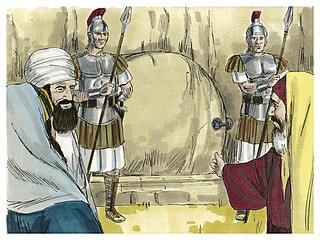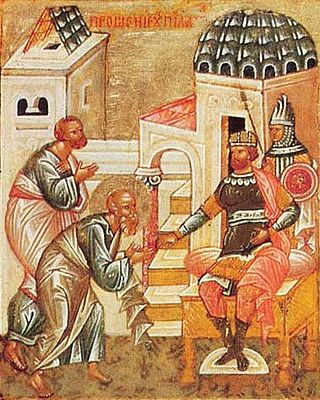
The Gospel of Matthew is the first book of the New Testament of the Bible and one of the three synoptic Gospels. It tells how Israel's Messiah, Jesus, comes to his people but is rejected by them and how, after his resurrection, he sends the disciples to the gentiles instead. Matthew wishes to emphasize that the Jewish tradition should not be lost in a church that was increasingly becoming gentile. The gospel reflects the struggles and conflicts between the evangelist's community and the other Jews, particularly with its sharp criticism of the scribes and Pharisees with the position that through their rejection of Christ, the Kingdom of God has been taken away from them and given instead to the church.

Matthew 3:7 is the seventh verse of the third chapter of the Gospel of Matthew in the New Testament. The verse occurs in the section introducing John the Baptist. In this verse John attacks the Pharisees and Sadducees.

Matthew 27:3 is the third verse of the twenty-seventh chapter of the Gospel of Matthew in the New Testament. This verse returns to the story of Judas Iscariot who, in the previous chapter, had accepted payment to betray Jesus to the Jewish authorities. This verse opens the story of Judas' remorse and death, interrupting the Gospel's narrative regarding the trials of Jesus.

Matthew 27 is the 27th chapter in the Gospel of Matthew, part of the New Testament in the Christian Bible. This chapter contains Matthew's record of the day of the trial, crucifixion and burial of Jesus. Scottish theologian William Robertson Nicoll notes that "the record of this single day is very nearly one-ninth of the whole book".

Matthew 28:1 is the first verse of the twenty-eighth chapter of the Gospel of Matthew in the New Testament. This verse opens the resurrection narrative as Mary Magdalene and "the other Mary" visit Jesus' tomb after the crucifixion.

Matthew 28:4 is the fourth verse of the twenty-eighth chapter of the Gospel of Matthew in the New Testament. This verse is part of the resurrection narrative; describing the reaction of the tomb guards after the arrival of the angel of the Lord and the occurrence of an earthquake that opened the tomb.
Matthew 28:11 is the eleventh verse of the twenty-eighth chapter of the Gospel of Matthew in the New Testament. This verse is part of the resurrection narrative. In this verse some of the guards at the tomb return to Jerusalem to report to the chief priests.
Matthew 28:12 is the twelfth verse of the twenty-eighth chapter of the Gospel of Matthew in the New Testament. This verse is part of the resurrection narrative. In this verse the guards of the tomb, after being present for an angel hearkening the resurrection, are bribed by the priests to lie about what they saw.
Matthew 28:13 is the thirteenth verse of the twenty-eighth chapter of the Gospel of Matthew in the New Testament. This verse is part of the resurrection narrative. In this verse the guards of the tomb, after being present for an angel hearkening the resurrection, were told what to say by the priests of Jerusalem after being bribed.

Matthew 27:65–66 are the final two verses of the twenty-seventh chapter of the Gospel of Matthew in the New Testament, coming after the crucifixion and entombment of Jesus. The chief priests and the Pharisees meet with Pontius Pilate, and he approves their request for a tomb guard.

Matthew 27:63 is the sixty-third verse of the twenty-seventh chapter of the Gospel of Matthew in the New Testament. This verse occurs after the crucifixion and entombment of Jesus. In it the chief priests and the Pharisees are meeting with Pontius Pilate.

Matthew 27:64 is the sixty-fourth verse of the twenty-seventh chapter of the Gospel of Matthew in the New Testament. This verse occurs after the crucifixion and entombment of Jesus. In it the chief priests and the Pharisees, who are meeting with Pontius Pilate, ask for a guard for the tomb.

Matthew 27:61 is the sixty-first verse of the twenty-seventh chapter of the Gospel of Matthew in the New Testament. This verse describes two women waiting by the Tomb of Jesus after the crucifixion.

Matthew 27:60 is the sixtieth verse of the twenty-seventh chapter of the Gospel of Matthew in the New Testament. This verse describes the Entombment of Jesus by Joseph of Arimathea after the crucifixion.

Matthew 27:59 is the fifty-ninth verse of the twenty-seventh chapter of the Gospel of Matthew in the New Testament. This verse describes Joseph of Arimathea gathering Jesus' body after the crucifixion.

Matthew 27:58 is the fifty-eighth verse of the twenty-seventh chapter of the Gospel of Matthew in the New Testament. This verse describes Joseph of Arimathea meeting with Pontius Pilate to secure the burial of Jesus.

Matthew 27:57 is the fifty-seventh verse of the twenty-seventh chapter of the Gospel of Matthew in the New Testament. This verse begins a discussion of the burial of Jesus and introduces Joseph of Arimathea.

Matthew 27:55–56 are the fifty-sixth and fifty-seventh verses of the twenty-seventh chapter of the Gospel of Matthew in the New Testament. The crucifixion and death of Jesus have just occurred, and these verses make note of a group of women who were present at that event.

Matthew 7:29 is the twenty-ninth verse in the seventh chapter of the Gospel of Matthew in the New Testament. It ends a two verse conclusion following the Sermon on the Mount.

Matthew 27:1 is the first verse of the twenty-seventh chapter of the Gospel of Matthew in the New Testament. This verse begins the chapter on the trial and crucifixion of Jesus.

















